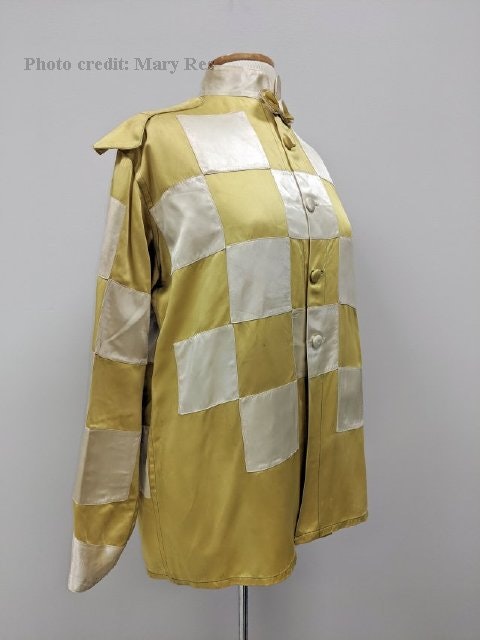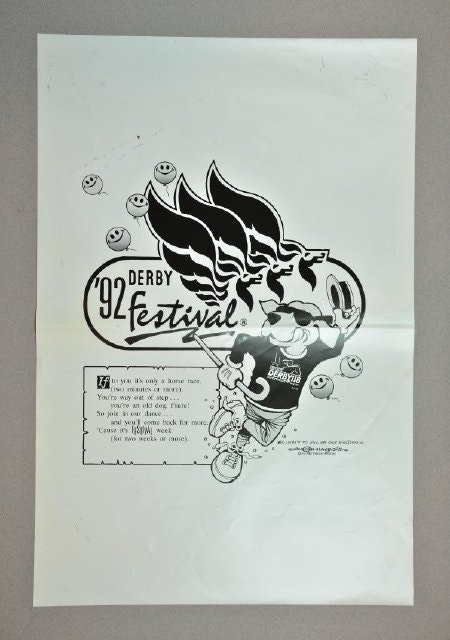Women at the Kentucky Derby
Elwood—the 15-1 long shot—wins the 1904 Kentucky Derby in exciting fashion. This was an impressive, come-from-behind race that left fans cheering. But did you know, Elwood was not only a long shot, but the first Derby winner bred and owned by a woman? Let’s take a step deeper into the history of the Kentucky Derby and examine the groundbreaking women who made their mark on the oldest continuously held Thoroughbred race in the nation.

When the grandstands of Louisville’s Churchill Downs were completed in 1875, women were confined to their own special section separate from the men. The “ladies’ section” was constructed to keep women separate from the immoral betting shed and drinking prevalent throughout the day at the races. [1] Despite the restrictions, women found ways to place bets and enjoy in the fun intended to be exclusively for men. The 1930 Derby Special Edition of the Kentucky Progress Magazine recounts the experiences of a gentleman attending the race for the first time. In his account, he tells of a young woman who approaches him and asks him to place a bet for her, which he excitedly does. [2]
Women began to infiltrate this men’s-only club through horse ownership. Lasca Durnell is often credited as being the first woman to own a starter and winner in the Kentucky Derby. Her horse, Elwood, bred by Mrs. J. B. Prather in Missouri, was gifted to her as a wedding present from her husband. Elwood won the 1904 Kentucky Derby, making Durnell the first woman to take home the trophy.
Several other women owners have also been successful in the Derby. Ethel Mars, owner of Gallahadion, won the 1940 race. During the 1940s and 1950s, one of the leading racing stables in the Derby was owned by Elizabeth Arden, inventor and owner of one of the largest cosmetic companies in the United States. In 1947 Arden won the Kentucky Derby with Jet Pilot. The women who owned their own racehorses demonstrated how that ownership gave them agency over their money and influence in the equine industry.
Entering the world of jockeying for women would prove to be the final, and biggest, challenge to overcome. Women were not allowed to become a licensed jockey until 1968. The first woman to achieve this was Kathryn Kusner, who applied for a professional jockey license in the early 1960s. However, she was denied because of her gender. After the passage of the 1964 Civil Rights Act, which outlawed discrimination based on race, sex, ethnicity, or religion, Kusner sued the Maryland Racing Commission for her right to a license and won. Kusner went on to win a silver medal for the United States Equestrian Team at the 1972 Olympics. She was the first woman to win a medal for the equestrian team and one of the first women to join the team. Thanks to Kusner, women were now able to apply for a jockey license and compete in large-scale races.
However, it was not until 1970 that a female jockey competed in the Kentucky Derby. Diane Crump broke that 95-year male-only streak. Crump grew up in Florida and worked on a horse farm breaking in yearlings and exercising horses. Crump applied and received her jockey license in Florida in 1969. Her first race was at Hialeah Park Racetrack where she was the first woman jockey to compete on a major United States racetrack (because the other two women who tried before Crump were boycotted). During her first race in Florida, insults and other verbal harassments were thrown at her. Later in 1969, police had to escort her to a race. In 1970, Crump made history as the first woman jockey to compete in the Kentucky Derby. Despite the difficulty for women to receive mounts, which affected the races they could compete in and what purses they were able to win, Crump was successful in her career.
The next woman to break barriers at Churchill Downs was Patricia Cooksey in 1984. Cooksey began her racing career in 1979 and eventually became the first female jockey to compete in the Preakness. She was inducted into the Kentucky Athletic Hall of Fame in 2002 and ended her career with 2,137 wins, the second most winnings of female jockeys. Toward the end of her career, Cooksey was diagnosed with breast cancer which she later defeated and continued racing. Just one year after battling cancer, while racing at Keeneland, Cooksey broke both her legs. Despite these challenges, Cooksey continued to race but found she was not being given competitive horses. She decided to retire from professional racing in 2004.
“"It's been a wonderful career and I'm leaving a lot behind," she said. "I don't feel like I can't do my job anymore. I just feel like I'm not getting the opportunities to be able to do my job, and it's very frustrating when I know that I can do better.” [3]
Andrea Seefeldt became the third woman to race at Churchill Downs in 1991 and the first to participate in the Pimlico Special and to win the Pennsylvania Derby. She began racing professionally in 1981 and placed fourth in the nation for female jockey earnings. Despite facing a series of injuries, Seefeldt remained determined to get back out on the racetrack and became the second woman ever to ride in the Preakness in 1994. Seefeldt retired in 2014.
Julie Krone was the fourth woman to compete in the Kentucky Derby in 1992 and 1995 but achieved the title of “first” in many events. Krone began her racing career in 1981 and was the first leading female rider at many New Jersey and Florida racetracks. She became the first woman to win the Triple Crown in 1993 and the first woman to win a Breeder’s Cup in 2003. Krone carries the title of having the most victories out of all female jockeys at 3,704 wins. In 2000, Krone became the first woman to be inducted into the Racing Hall of Fame. She officially retired in 2004 but kept her ties with horseracing. Krone is currently the most successful woman Thoroughbred jockey of all time.
The fifth woman to race in the Derby was Rosemary Homeister Jr. in 2003. Homeister grew up in the world of racing as her mother was an owner, trainer, and jockey. Early in her career she became the second leading apprentice jockey in the country in 1992. That same year she was runner-up for the Eclipse Award and went on to receive the award in 1993. After the birth of her daughter in 2011 Homeister came back to the racetrack more ambitious than ever. She retired in 2015 with the second-best win record among women jockeys at 2,784. [4]
The sixth and last woman (for now) to race in the Kentucky Derby was Anna “Rosie” Napravnik in 2011, 2013, and 2014. Napravnik grew up riding horses and began her career in 2005. She was an immediate success racking up the wins and gaining a fan base at just seventeen years old. In her first Derby run in 2011, Napravnik set the record for the highest finish for a female jockey in the Derby at ninth place. In 2012, Napravnik became the first woman jockey to win the Kentucky Oaks and the second woman to win the Breeder’s Cup. In 2013 she topped the previous highest Derby record she placed herself, coming in at fifth place. Napravnik retired in 2014 after a record-breaking career and runs a private training operation specializing in transitioning retired horses to new careers. [5]
All the women discussed above, and those that could not fit into this post, are an inspiration to many. They showed great strength and willpower and did not let anything, or anyone stand in their way; and they made history doing it.
Check out the Right to Ride exhibit at the Kentucky Derby Museum next time you’re in Louisville. The exhibit explores the history of women jockeys breaking barriers and making it possible for women to compete in professional horse races. https://www.derbymuseum.org/Exhibits/Detail/35/Right-to-Ride
Links to our collection:

This Derby Festival poster created by Hugh Haynie celebrates the 1992 Kentucky Derby where Julie Krone became the fourth woman to compete in the Derby.

This jockey silk was owned by Anita Madden. Known for her extravagant Derby eve parties, Madden developed the business district of Hamburg in Lexington and served on the Kentucky Horse Racing Commission as the first female commissioner from 1980-1983.
Footnotes:
[1] “Inaugural Day at Churchill Downs An Immense Success in Every Particular,” Courier-Journal (Louisville, Kentucky), May 10, 1889.
[2] John Thornton, “My Experience at the Kentucky Derby,” Kentucky Progress Magazine 2, no. 9 (1930): 19.
[3] “Patricia Cooksey Ends Her Riding Career,” Blood-Horse, June 25, 2004.
[4] “Jockey Profile: Rosemary B. Homeister, Jr.” Equibase, Accessed January 10, 2024.
[5] Visit Homeister’s website.

